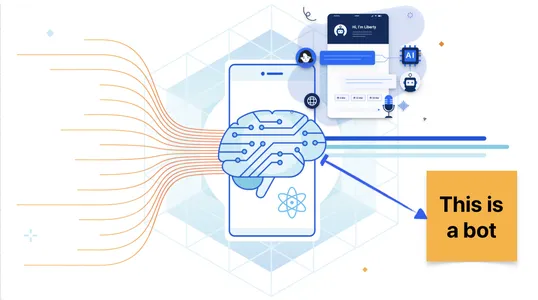Introduction
This article presents an overview of the problem of bot detection, emphasizing the key challenges related to detecting bots. It explores various techniques and methods widely employed to identify and block bot activity. The article will also discuss the implications of bot detection for online privacy, security. It also examines the role of machine learning and artificial intelligence in improving the accuracy and efficiency of bot detection.

Learning Objectives:
- Understand the concept of bot detection in the context of data science
- Explore the various types of bots encountered in online platforms
- Examine different techniques and algorithms used for bot detection
- Comprehend the role of data science and machine learning in bot detection
- Discuss the limitations and challenges of bot detection and potential future developments
This article was published as a part of the Data Science Blogathon.
Table of contents
What are Bots?
Software programs known as bots are designed to perform tasks on the internet without human intervention. They can range from simple web scrapers and data entry bots to more sophisticated chatbots, social media bots, malware bots, and spam bots. Bots possess certain characteristics that differentiate them from human users, including speed, consistency, lack of emotion, repetitive behavior, and limited creativity.

There are different types of bots that serve various purposes. Some common types of bots include:
- Web crawlers: Bots that automatically scan websites and collect data for different search engines and other applications
- Chatbots: Bots that simulate human conversation and provide automated customer service or support on messaging platforms.
- Social media bots: Bots that create and manage social media accounts, automate posting and commenting, and manipulate online discourse.
- Malware bots: Bots that infect computers and devices with malware and perform malicious activities such as stealing data and launching cyberattacks.
- Spam bots: Bots that send unsolicited messages and advertisements to users on email and messaging platforms.
Bots share certain characteristics that distinguish them from human users. Some of these characteristics include:
- Speed: Bots can perform tasks at a much faster rate than humans.
- Consistency: Bots can perform tasks with a high degree of accuracy and consistency.
- Lack of emotion: Bots do not have emotions or subjective biases that can influence their behavior.
- Repetitive behavior: Programmers create bots to perform specific tasks repeatedly.
- Lack of creativity: Bots do not have the ability to think creatively or adjust to new situations in the same manner that humans do.
Why Do Bots Exist?
Bots exist for a variety of reasons, depending on the intentions of their creators. Some common reasons for bot creation include:
- Efficiency:Bots can perform tasks faster and more efficiently than humans, making them useful for automating repetitive or time-consuming tasks.
- Malicious activities: Use bots for malicious activities such as spreading spam, launching cyber attacks, and stealing data.
- Marketing and advertising: Use bots to promote products and services by generating fake user reviews and social media engagement.
- Research and data collection: Use bots to collect data from the internet for research purposes or to inform business decisions.

Examples of bot usage include:
- Web scraping: Use bots to retrieve data from websites that can be useful for market research, price comparison, and other business purposes.
- Customer service: Chatbots provide automated customer support on messaging platforms, reducing the need for human intervention.
- Social media manipulation: Use bots to create and manage fake social media accounts, artificially inflate engagement metrics, and spread misinformation.
- Cyber attacks: Use malware bots to infect computers and devices with malware, which can be used to steal data, launch DDoS attacks, and carry out other malicious activities.
- Gaming: Use bots to automate gameplay and gain unfair advantages in online games.
Bot Detection Techniques
Some of the different techniques to detect bots, include:
- Behavioral Analysis: This technique involves analyzing user behavior patterns to distinguish between human and bot activity.
- Device Fingerprinting: This technique involves analyzing unique characteristics of the device that accesses a website or application to identify bots.
- CAPTCHAs: This technique involves using puzzles or challenges that are difficult for bots to solve but easy for humans.
- Machine Learning: This technique involves training algorithms to identify patterns and characteristics associated with bot activity.

Each bot detection technique has its own advantages and disadvantages. Some of these include:
- Behavioral Analysis
Advantage: It can detect previously unseen bots and can provide insight into the behavior of human users as well.
Disadvantage: It can be time-consuming and also expensive to set up and may produce false positives or false negatives.
2. Device Fingerprinting
Advantage: It is effective at identifying bots that use automated tools or scripts and provides a high level of accuracy.
Disadvantage: Sophisticated bots using spoofed or virtual devices can bypass it, potentially collecting sensitive device information and raising privacy concerns.
3. CAPTCHAs
Advantage: It is effective at blocking simple bots that don’t have sophisticated AI capabilities.
Disadvantage: Human users find it inconvenient and frustrating, as bots can bypass it using machine learning or other advanced techniques.
4. Machine Learning
Advantage: It achieves a high level of accuracy in adapting to new types of bot activity and detects subtle patterns that are challenging for humans to identify.
Disadvantage: It requires a vast amount of training data to be effective and can be vulnerable to attacks that aim to manipulate the training data or the machine learning algorithms.
We have seen the advantages and disadvantages of each bot detection technique now let’s see some real world examples of them.
Real-world Examples
- Behavioral Analysis: Some cybersecurity companies utilize this technique to detect botnet activity. They analyze the behavior of network traffic and identify patterns of communication between devices.
- Device Fingerprinting: Some websites and applications use this technique to detect bot activity. They analyze the characteristics of the device used to access the service, including the user agent, screen resolution, and other device attributes.
- CAPTCHAs: Websites commonly employ this technique to prevent automated account creation, comment spam, and other types of bot activity.
- Machine Learning: Companies like Google utilize this technique to detect bot activity on their platforms. They train machine learning algorithms to identify patterns of behavior associated with bots.
Machine Learning for Bot Detection
ML, as part of artificial intelligence, involves training algorithms to learn patterns and relationships in data without explicit programming. It is widely used in bot detection by training algorithms on extensive datasets of user behavior, network traffic, or other relevant data. This training enables the identification of patterns associated with bot activity. The trained algorithms can then automatically classify new data as either bot or non-bot activity.

The benefits of using machine learning for bot detection include the following:
- Scalability: Machine learning algorithms can process large amounts of data quickly, making them suitable for detecting bot activity in real time.
- Adaptability: Machine learning algorithms can be trained on new data to adapt to new types of bot activity, making them more effective at detecting new and evolving threats.
- Accuracy: Machine learning algorithms can identify subtle patterns in the data that are difficult for humans to detect, making them more accurate than traditional rule-based methods.
Limitations of using machine learning for bot detection include:
- Bias: Machine learning algorithms are sometimes biased if the training data is unrepresentative of the population being analyzed.
- Complexity: Machine learning algorithms may be complex and difficult to interpret, hence making it difficult to understand how they arrive at their decisions.
- Overfitting: Machine learning algorithms can overfit the training data, making them less effective at detecting new and unseen bot activity.
Now Let us understand this through a simple code example, one can just open Google Collab and try to implement the following code to understand better.
Code Example
We shall create a dummy dataset and work with it for illustration purpose
import pandas as pd
# Define dummy data
data = { 'num_requests': [50, 100, 150, 200, 250, 300, 350, 400, 450, 500], 'num_failed_requests': [5, 10, 15, 20, 25, 30, 35, 40, 45, 50], 'num_successful_requests': [45, 90, 135, 180, 225, 270, 315, 360, 405, 450], 'avg_response_time': [100, 110, 120, 130, 140, 150, 160, 170, 180, 190], 'is_bot': [0, 0, 0, 0, 0, 1, 1, 1, 1, 1]
} # Convert data to pandas dataframe
df = pd.DataFrame(data) # Save dataframe to csv file
df.to_csv('bot_data.csv', index=False) from sklearn.ensemble import RandomForestClassifier
from sklearn.model_selection import train_test_split
from sklearn.metrics import accuracy_score # Load dataset
data = pd.read_csv('bot_data.csv') # Split dataset into training and testing sets
X_train, X_test, y_train, y_test = train_test_split( data.drop('is_bot', axis=1), data['is_bot'], test_size=0.3) # Initialize random forest classifier
rfc = RandomForestClassifier() # Train classifier on training set
rfc.fit(X_train, y_train) # Predict labels for test set
y_pred = rfc.predict(X_test) # Evaluate the accuracy of classifier
accuracy = accuracy_score(y_test, y_pred)
print('Accuracy:', accuracy)
import pandas as pd
from sklearn.ensemble import RandomForestClassifier
# Load trained model
rfc = RandomForestClassifier()
rfc.fit(X_train, y_train)
Now that we have trained our model and we have got good accuracy. (Note: In real word scenarios accuracy may vary a lot) we can now test our model by giving new random data.)
# Create new request data
new_data = { 'num_requests': [500], 'num_failed_requests': [60], 'num_successful_requests': [200], 'avg_response_time': [190]
} # Convert new data to pandas dataframe
new_df = pd.DataFrame(new_data) # Predict whether new data represents a bot or not
prediction = rfc.predict(new_df)
if prediction[0] == 1: print('This request data is likely from a bot.')
else: print('This request data is likely from a human.') 
Human Involvement in Bot Detection
Humans utilize their cognitive abilities to identify and interpret intricate patterns that machines may struggle to recognize.
The advantages of human Involvement in bot detection include the following:
- Humans are able to detect subtle patterns and anomalies that may not be easily identifiable by machines.
- Humans adapt to new and evolving bot threats and can quickly update detection strategies to stay ahead of attackers.
- Human experts can bring specialized knowledge and skills to bot detection efforts, such as knowledge of specific industries or technologies.
Limitations
The limitations of human Involvement in bot detection include the following:
- Subjectivity: Human detection can be subjective and prone to biases and errors.
- Time-consuming: Manual detection can be time-consuming and labor-intensive, particularly in large datasets.
- Scalability: Human detection may not be scalable, particularly in real-time detection scenarios.
Industry Based Examples
Examples of successful human-led bot detection efforts include:
- In the United States (CISA) Cybersecurity and Infrastructure Security Agency has a team of analysts that monitor network traffic for signs of bot activity. The analysts use their expertise to identify suspicious activity and then work with automated tools to confirm and mitigate the threat.
- Financial institutions often rely on human analysts to detect fraudulent activity, including bot-driven attacks such as account takeovers and credential stuffing.
- The Wikimedia Foundation uses a combination of automated and manual bot detection techniques to identify and block bots on Wikipedia. Human editors use a variety of strategies to detect and block bots, including analyzing edit histories, IP addresses, and user behavior.
Now that we have known the significance of human intervention and the importance of bots accurately distinguishing between human and bot requests, let’s proceed to test our model’s performance with a sample data point. We will examine whether our model correctly predicts whether a given request is from a human or a bot.
Code Example
import pandas as pd
from sklearn.ensemble import RandomForestClassifier # Load trained model
rfc = RandomForestClassifier()
rfc.fit(X_train, y_train) # Create new request data
new_data = { 'num_requests': [100], 'num_failed_requests': [10], 'num_successful_requests': [90], 'avg_response_time': [120]
} # Convert new data to pandas dataframe
new_df = pd.DataFrame(new_data) # Predict whether new data represents a bot or not
prediction = rfc.predict(new_df)
if prediction[0] == 1: print('This request data is likely from a bot.')
else: print('This request data is likely from a human.') 
Real-World Examples and Case Studies
Numerous organizations and cybersecurity firms have recognized the importance of data science techniques in bot detection and have implemented them in their platforms. Let’s explore a few real-world examples:
- Social Media Networks: Social media platforms are often targeted by bots seeking to spread misinformation, manipulate public opinion, or engage in spam activities. Data science plays a crucial role in identifying and mitigating these bot activities. Machine learning models are trained on large volumes of user data to detect suspicious behavior patterns, such as mass creation of fake accounts, automated content posting, or coordinated network interactions.
- E-commerce Sites: Online marketplaces face challenges such as price scraping bots, which extract pricing information to gain a competitive advantage or manipulate prices. Data science techniques enable the identification and blocking of such bots by analyzing browsing behavior, IP addresses, and purchase patterns. Machine learning algorithms can recognize patterns of abnormal data access and distinguish between legitimate users and malicious bots.
- Financial Institutions: Banks and financial institutions are prime targets for bot-driven fraudulent activities, such as account takeover, identity theft, or fraudulent transactions. Data science plays a vital role in building fraud detection systems that can identify suspicious behavior, flagging potential bot-driven activities for further investigation. By analyzing transaction patterns, user behavior, and device information, machine learning models can detect anomalies and protect customer accounts.
The Future of Bot Detection

- Complexity of Bot Attacks: Bots are becoming more sophisticated, making them harder to detect using traditional methods.
- The Rise of Machine Learning: While ML is effective at detecting bots, it requires large amounts of data and expertise to train models. This makes it difficult for smaller organizations to implement.
- Balancing Accuracy and Usability: Bot detection tools must strike a balance between accuracy and usability. As overly complex tools may be difficult for non-experts to use effectively.
Potential future developments in bot detection technology:
- Advancements in Machine Learning: Machine learning algorithms will continue to improve, making them more effective at detecting bots.
- Increased Use of Behavioral Analysis: Look at how users interact with systems over time, may become a more common approach to detecting bots.
- Greater Use of Automation: As bots become more advanced, automated systems will become increasingly important for detecting and mitigating bot attacks.
The importance of continued research in bot detection:
- As bot attacks continue to evolve, continued research is necessary to stay ahead of attackers.
- Collaboration and information sharing between researchers, practitioners, and organizations are crucial for staying abreast of emerging bot threats.
- Developing more accessible bot detection tools will help organizations of all sizes protect themselves from bot attacks.
Conclusion
Bot detection is a critical aspect of data science and cybersecurity, aimed at identifying and mitigating automated programs that mimic human behavior. Through the implementation of various techniques, including behavioral analysis, device fingerprinting, CAPTCHAs, and machine learning algorithms, data scientists can develop robust bot detection systems. Data science techniques enable scalability, adaptability to new threats, and the detection of subtle patterns. However, challenges such as bias in training data and the interpretability of complex models need to be addressed. As the field evolves, collaboration, real-time detection, and advanced machine learning techniques will continue to shape the future of bot detection, ultimately safeguarding online interactions and maintaining trust in digital platforms.
Key Takeaways
- Bots are nothing but automated programs that can perform a variety of tasks online.
- Bot detection is important for protecting against malicious bot activity, which can include account takeover, spamming, and denial-of-service attacks.
- There are various bot detection techniques, including IP-based blocking, signature-based detection, and machine learning.
- Machine learning is an effective method for bot detection, but it requires large amounts of data and expertise to implement.
- Human Involvement is also important in bot detection, as human experts can identify patterns and behaviors that may be missed by automated systems.
- The future of bot detection will likely involve a combination of both human expertise and also machine learning tools, with an emphasis on automation and behavioral analysis.
The media shown in this article is not owned by Analytics Vidhya and is used at the Author’s discretion
Related
- SEO Powered Content & PR Distribution. Get Amplified Today.
- PlatoAiStream. Web3 Data Intelligence. Knowledge Amplified. Access Here.
- Minting the Future w Adryenn Ashley. Access Here.
- Buy and Sell Shares in PRE-IPO Companies with PREIPO®. Access Here.
- Source: https://www.analyticsvidhya.com/blog/2023/05/guardians-of-the-internet-power-of-data-science-in-bot-detection/



